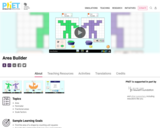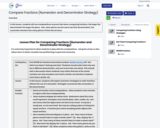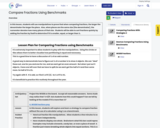
Fractions, Decimals, and Percents with Number Lines Algebra Readiness Remediation Plan
- Subject:
- Mathematics
- Material Type:
- Lesson Plan
- Provider:
- VDOE
- Author:
- VDOE
- Date Added:
- 10/07/2024

Fractions, Decimals, and Percents with Number Lines Algebra Readiness Remediation Plan

Hundreds Grids Rational Number Equivalencies Algebra Readiness Remediation Plan

Adding and subtracting fractions with like denominators - Mathematics Instructional Plans (MIPs) help teachers align instruction with the 2016 Mathematics Standards of Learning (SOL) by providing examples of how the knowledge, skills and processes found in the SOL and curriculum framework can be presented to students in the classroom.

Adding and subtracting fractions using context as a tool to support student understanding Mathematics Instructional Plans (MIPs) help teachers align instruction with the 2016 Mathematics Standards of Learning (SOL) by providing examples of how the knowledge, skills and processes found in the SOL and curriculum framework can be presented to students in the classroom.

Create your own shapes using colorful blocks and explore the relationship between perimeter and area. Compare the area and perimeter of two shapes side-by-side. Challenge yourself in the game screen to build shapes or find the area of funky figures. Try to collect lots of stars!

Build fractions from shapes and numbers to earn stars in this fractions game or explore in the Fractions Lab. Challenge yourself on any level you like. Try to collect lots of stars!

Naming, Writing and Representing FractionsMathematics Instructional Plans (MIPs) help teachers align instruction with the 2016 Mathematics Standards of Learning (SOL) by providing examples of how the knowledge, skills and processes found in the SOL and curriculum framework can be presented to students in the classroom.

This lesson is part of the Virginia K-12 Computer Science Pipeline which is partly funded through a GO Virginia grant in partnership with Chesapeake Public Schools, Loudoun County Public Schools, and the Loudoun Education Foundation. During this lesson, students will program a Bee-Bot (or similar robot) to locate fraction models.

In this lesson, students will use manipulatives to prove that when comparing fractions, the larger the denominator the larger the piece. Also, when pieces are the same size (the denominator), the numerator denotes how many pieces of that size we have.

In this lesson, students will use manipulatives to prove that when comparing fractions, the larger the denominator the larger the piece. Also, when pieces are the same size (the denominator), the numerator denotes how many pieces of that size. Students will be able to sort fractions quickly by adding the fraction by itself to determine if it is smaller, equal, or larger than ½.

This resource is a series of slides that asks students to compare a given fraction to the benchmark numbers of 0, 1/2, and 1. This product also asks students to make generalizations about sets of fraction that are all equal to 1/2, have the same denominator, or all are one unit fraction piece away from a whole. This product is best used in conjunction with fraction strips.

Comparing Fractions. Mathematics Instructional Plans (MIPs) help teachers align instruction with the 2016 Mathematics Standards of Learning (SOL) by providing examples of how the knowledge, skills and processes found in the SOL and curriculum framework can be presented to students in the classroom.

This is a Jamboard to compare fractions. The students will drag <, >, or = to make each statement true.

This video is part of the Learn and Grow with WHRO TV series. In this session, students compare fractions using words and symbols for greater than, less than, and equal too.

3.2c Comparing Fractions Co-Teaching MIP

Jamboard comparing fractions, decimals, and percents. Students will click on sticky notes and drag to boxes. These will be put in order from least to greatest.

Within this interactive lesson, students will navigate and explore comparing positive and negative fractions, deicmals, and percents through Desmos. Students will also gain practice from finding equivalencies, using picture representations and number lines, and through mathematical discourse. Students will be able to do the following:Use a number line to sort, compare, and order integers, fractions, decimals, and percents.Compare integers, fractions, decimals, and percents.Order integers, fractions, decimals, and percents.

Within this interactive lesson, students will navigate and explore comparing positive and negative fractions, deicmals, and percents through Desmos. Students will also gain practice from finding equivalencies, using picture representations and number lines, and through mathematical discourse. Students will be able to do the following:Use a number line to sort, compare, and order integers, fractions, decimals, and percents.Compare integers, fractions, decimals, and percents.Order integers, fractions, decimals, and percents.

Within this interactive lesson, students will navigate and explore comparing positive and negative fractions, deicmals, and percents through Desmos. Students will also gain practice from finding equivalencies, using picture representations and number lines, and through mathematical discourse. Students will be able to do the following:Use a number line to sort, compare, and order integers, fractions, decimals, and percents.Compare integers, fractions, decimals, and percents.Order integers, fractions, decimals, and percents.

Encourage students to use strategies to convert fractions to decimals.